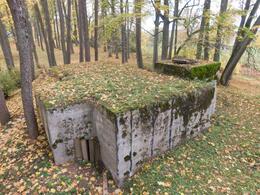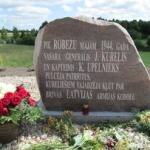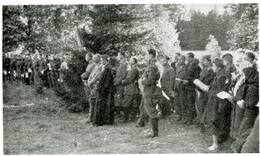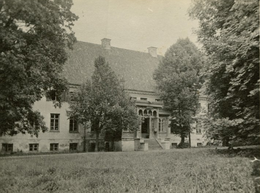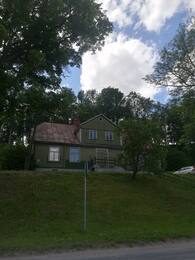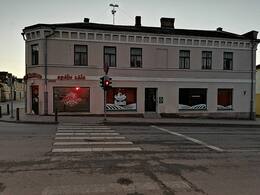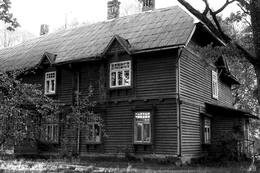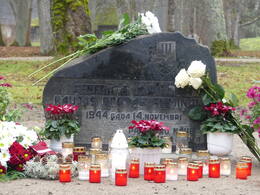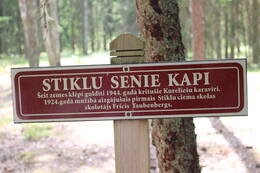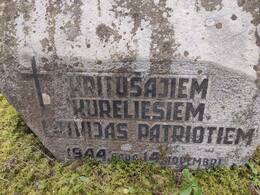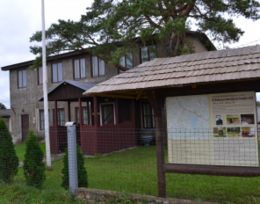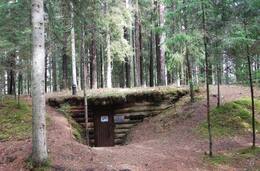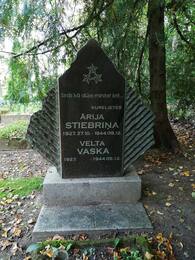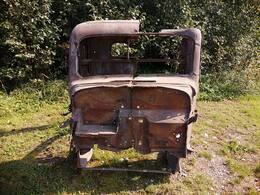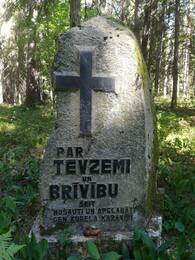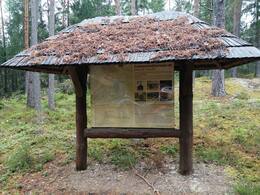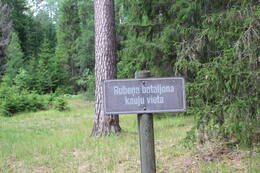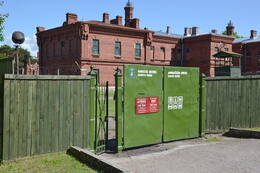Kurelis: for Latvia against foreign occupying powers
World War II Bunkers in Malnava and Hitler’s Visit to the Headquarters of the German Army Group North
Hitler’s visit to the Headquarters of the German Army Group North in Malnava and the air defence bunker are mentioned as related sites. However, apart from the location – Malnava Manor, there is no other link between them.
From 12 to 28 July 1941, the headquarters of the German Army Group North, which was waging an attack against Leningrad, was located in Malnava Manor. The reason for the choice of location was practical: Malnava Agricultural School, which was located in a former manor house, had modern facilities: electric lighting, centralised water supply, showers, and sewerage. The headquarters of Group North was located in one of the side blocks of the manor, while the rest of the building continued to operate as an agricultural school. Hitler’s visit to the Group North headquarters in Malnava took place on 21 July 1941. Hitler and his entourage arrived in two Junkers aircraft, accompanied by nine Messerschmitt fighters. The visit only lasted for a few hours and is immortalised both in German military newsreels from the front and in the memories of the pupils of Malnava.
The air defence bunker, located about 70 metres from the manor house, was built at the beginning of 1944 when Soviet aviation began to dominate the airspace in the second half of the war. At that time, the retreat process of German troops was in progress. In 1944, the Headquarters of the German Army Group North stayed in Malnava from February to mid-July.
Memorial stone to the Kurelians in Skrīveri parish
A memorial stone for the Kureli people near the "Borders" house in Skrīveri parish, unveiled in 2015.
"Border" houses in Skrīveri parish
The "Border" houses in Skrīveri parish are the place where the formation of General J. Kurelis' group began on July 28, 1944.
Strazde Manor
Strazde Manor is located on the side of the Riga-Ventspils highway and was the headquarters of General Jānis Kurelis' group from September 29 to October 28, 1944. The Skrīveri Battalion commanded by Lieutenant Colonel Eduards Graudiņš was stationed in the manor buildings. The Kurelis were a military unit formed in Vidzeme in the summer of 1944 from the Riga District Guards, whose goal was to restore Latvia's independence between the retreat of the German army and the attack of the USSR troops on Latvian territory.
Heavily rebuilt for the needs of a school (from 1922), it has lost its original appearance and proportions during the reconstruction. Strazde Manor is surrounded by a beautiful park.
Jekeln headquarters in Talsi
In this building in Talsi, on November 3, 1944, General J. Kurelis and Captain K. Upelnieks held talks with SS Obergruppefuhrer F. Jekeln and other German officers. The historic building has been demolished, and a new building is being built in its place.
Former store/police building
Former shop/police building in Talsi, Kr.Valdemāra 2, where the officers of General J. Kurelis' group headquarters were imprisoned from November 14 to 19, 1944.
Kurelian headquarters in Stiklos
The Annahite Hunting Lodge in Stikli was the headquarters of the Kurelians during World War II from October 29 to November 14, 1944. This building has survived to this day.
The surroundings of Stikli are rich not only with swamps and forests, but also with sand. In 1897, the new Annahite glass factory began operating - this is how this Latvian settlement got its name Stikli. In 1900, right there on the shore of Lake Stikli, the so-called Annahite hunting castle was built, or rather, a building in which the factory manager lived.
Memorial stone to the Kurelians in Stiklos
Memorial stone to the Kurelians near the Annahite hunting lodge "Stiklos" in Puze parish, discovered in 1997, relocated in 2023.
An information plaque with a QR code is located near the stone, where an audio guide tells the story of the Kurelians.
Memorial site at the old Annahite cemetery
A memorial site in the old Annahite cemetery, where soldiers and civilians killed on November 14, 1944 as a result of the German siege of the headquarters and main forces of General J. Kurelis' group are buried.
Memorials to General J. Kurelis' group and Lieutenant R. Rubenis at the "Dzelzkalni" cemetery
Memorial stones for the group of General J. Kurelis and Lieutenant R. Rubenis at the “Dzelzkalni” cemetery in Puze parish. Unveiled in 1997.
The memorial signs were installed even before the establishment of the Rubenis Battalion Museum.
Rubenis' battalion museum
Rubenis’ Battalion Museum is located in Ugāle. It is dedicated to the Battalion of R. Rubenis, who served and fought under General J. Kurelis in Kurzeme in 1944, the activities of the Kurelians and the national resistance movement. Museum has an exhibit on the activities of the Latvian Central Council (LCC) and its Ventspils group, as well as the LCC Memorandum with 188 signatures and photographs of signatories that is included in the Latvian National Register of the UNESCO Memory of the World Programme. The LCC was a joint centre of Latvia's highest political leadership with an underground government that operated during the occupation of Latvia from 1943 to 1994. It was formed with the aim of coordinating the activities of various Latvian resistance movements in order to restore Latvia's national independence. The museum also offers a trip to places significant to the history of the battalion (settlement with a reconstructed bunker in the Usma parish, battlefields in Renda and Zlēkas parishes, etc.).
Rubenis' battalion bunker and battlefields
The restored dugout of the 2nd Company of the Rubenis Battalion is located in a forest by lake Ilziķi in the Usma parish. The dugout can be viewed from the outside for free at any time. However, tours inside the dugout must be booked in advance.
The Battalion of Lieutenant Robert Rubenis was part of a military unit formed by General Jānis Kurelis, and it is known for not surrendering to the German troops and showing heavy resistance. From November 14 to December 9 in 1944 fierce battles were fought in Ugāle, Usma, Renda and Zlēkas parishes between forces of the 16th German Army, SD and SS units under the command of the Police General Friedrich Jeckeln, and the battalion of the Kurelian unit commanded by Lieutenant Roberts Rubenis. The men under Rubenis’ command were well armed and organized and did not associate themselves with any of the two hostile occupying powers. Their actions are considered to be the most wide-spread and longest in the history of the Latvian national resistance movement. In battles near Renda and Zlēkas about 250 German soldiers fell, while only 50 casualties were suffered by Rubenis’ men. The events of those days are represented by the restored dugout in the forest (sod-covered, log cabin dug in the ground) where the men of the Rubenis Battalion once stayed.
Monument to the Rubenis Battalion Medics
Monument at the Cirkale cemetery to the priests Ārija Stiebriņa and Velta Vaska, who were shot by the Germans on November 9, 1944. Created by sculptor J. Karlovs.
The two women were shot by units of the German Nazi army on December 9, 1944, along with other captured residents of the Zlēki area, deserters from the German army, or the like.
According to the stories, the young women joined the Rubenis battalion voluntarily. They traveled with the Rubenis battalion from Suntaži to Usma. However, during Jekeln's "Eichensumpf" operation, the young women were arrested on the road, taken to the Vēlogi forester's house for interrogation and shot together with a small group of other detainees. A woman, a resident of Cirkale, knew Ārija and managed to rebury the remains of both girls at the edge of the Cirkale cemetery and maintained this cemetery throughout the Soviet occupation.
Under the leadership of the Supreme SS and Police Leader in Ostland, SS Obergruppenführer and Police General Friedrich Jeckeln, a large-scale operation, Eichensumpf ("Oak Swamp"), took place from December 5 to 9, which was directed against the Red Arrow fighters and General Kurel's group near Abava.
The course of the campaign is partially documented in a report dated December 31, 1944.
The scene of the collision near the Chubu houses in Renda parish
The "Chubu" houses are located north of Ozoli in Renda parish. The clash with the Germans near the Chubu houses of Lieutenant L. Znutēns' 2nd company of Lieutenant V. Strautnieks' battalion took place on November 16, 1944.
Monument to the executed soldiers of Lieutenant R. Rubenis' battalion
The Rubenis Battalion soldiers' cemetery is located on the Kuldīga - Sabile road, opposite the place where Renda's doctoral thesis used to be located. There is a signpost by the road and a memorial stone is located just a few hundred meters from the road.
Lieutenant Roberts Rubenis' battalion was one of the parts of the military unit formed by General Jānis Kurelis, which did not surrender to the German troops and showed fierce German resistance. During the Usma period, the battalion's numerical composition increased to 650 men with four fully equipped companies, an ambulance and a farm team. Commanding staff: Lieutenant R. Rubenis, Lieutenant Filipsons, Private A. Druviņš, Private Šulcs, Private Briedis, Private Sergeant J. Rubenis, Private J. Bergs, Private Jaunzems.
From November 14 to December 9, 1944, fierce battles took place in the Ugāle, Usma, Renda and Zlēki parishes between parts of the German 16th Army, SD and SS units under the command of Police General Friedrich Jekeln, and a separate battalion of the Kureli unit commanded by Lieutenant Roberts Rubenis. In the battles near Renda and Zlēki, about 250 German soldiers were destroyed, while the Rubenis suffered about 50 casualties.
After the death of Lieutenant Rubenis, Druvinš announced to his men that he would henceforth operate on a voluntary basis, and as a result, several dozen men decided to secede from the Rubenis battalion. On November 20-21, 1944, a group of 11 people was captured by a German SD unit and, after interrogation, taken to a local forest and shot.
The site of the battles of the Rubeņš Battalion on December 6-9, 1944
Memorial site at the site of the battles of Lieutenant R. Rubenis' battalion on December 6-9, 1944, between the houses of "Vēveris" and "Dzilns" in Ugāle parish.
The site of the Rubeņš Battalion's battles on November 18, 1944
Memorial site at the site of the battles of Lieutenant R. Rubenis' battalion on November 18, 1944, between the houses of "Pērkonas" and "Mežzīļi" in Renda parish.
The White Cross and the place of execution in Karosta
The White Cross and the place of execution opposite the Liepāja Karosta Prison. Unveiled in 2000.
The place where General Kurelis's staff officers were shot
At the end of July 1944, when the Red Army invaded the territory of Latvia, the German occupation authorities allowed Jānis Veide, the Riga District Police Chief and Commander of the 5th Riga Guards Regiment of the restored Latvian Guards Organisation, to establish the "General Kurelis Group of the Riga Guards Regiment". The head of the Military Commission of the Central Council of Latvia, General Jānis Kurelis of the Latvian Army, became its leader.
The Kurelis operated in Vidzeme until September 1944, when they moved to Kurzeme, where they were stationed in the houses of Stiklis in Puzes parish, Ilziķi in Usma parish, Iliņi in Ģibuli parish, and in Edole and other places in Northern Kurzeme. By the end of October 1944, the Kurelies had about 3,000 armed men, among them many former soldiers of the Latvian SS Volunteer Legion units, who joined the unit to realise their dream - the fight for Latvia's independence.
At the beginning of November 1944, the German occupation authorities' Supreme Police and SS leader in Ostland, SS Oberruppenführer Friedrich Jeckeln, began to restrict the group's activities and on 14 November arrested the Kurelian headquarters and more than 700 soldiers in Stikliai, Puse parish. The battalion commanded by Lieutenant Robert Rubens, with about 500 men in the Usma area, resisted and continued fighting until December 1944.
On the night of 19/20/1944, the Germans fought against the Germans. On November 19-19, 1944, a court-martial of the German occupation authorities was held in Liepāja Karaostas Prison, sentencing to death eight staff officers of General Kurelis' group - Colonel Pēteris Liepiņš, Captain Kristaps Upelnieks, Captain Jūlijs Mucenieks, Lieutenant Jānis Gregoras, Lieutenant Teodorma Prikulis, Lieutenant Jānis Rasas, Lieutenant Filipson and Adjutant Kārlis Valters. Three staff officers, Lieutenant Colonel Eduards Graudins, Lieutenant Arthurs Ankravs and Sergeant Vili Pavulāns, were pardoned for various reasons. On the afternoon of 20 November, the convicts were shot in the dunes near the Karosta prison, where a white cross can be seen today.
In 1994, a memorial to the officers who were shot was established in the dunes of the Liepaja Karosta. In 2012, after it was washed into the sea, the memorial was restored to its present location.
*** Translated with www.DeepL.com/Translator (free version) ***




